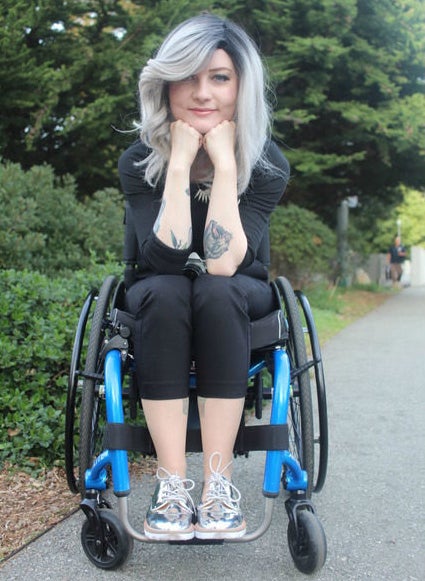
I used to see live music at least once a week, where I’d bathe in the colorful glow of stage lights while bass rattled my heart inside my rib cage. There is something transformative and healing about music ― you can almost reach out and touch it.
As a music lover, I scan Coachella’s lineup every year. The Coachella Valley Music and Arts Festival is held every spring in Indio, California. The list of musicians gets more and more incredible each year, and 2018 is no exception: Beyoncé, Chromeo, Flatbush Zombies, Hayley Kiyoko, Ibeyi...
The longer I look at the list, the more frustrated I feel.
Music isn’t so easy to see live anymore. Five years ago, I was diagnosed with an incurable degenerative disease called Ehlers-Danlos syndrome. EDS is a collagen disorder that causes a slew of symptoms and comorbidities, including random joint dislocation.
“My wheelchair ― my disability ― isn’t what prevents me from living my life to the fullest. Other people do that.”
There’s no warning before it happens; most mornings, my hands are fully dislocated from my wrists when I wake up. A hiccup or a sneeze can dislocate my ribs, and I deal with incredible daily pain as a result. I can no longer stand for hours at center stage under the glow of the lights without dislocating my hips; I use a wheelchair to get around. I’m able to walk without the chair, but never for very long.
Concerts are expensive when you’re chronically ill and constantly paying medical bills, but beyond this, many music venues aren’t wheelchair accessible ― even if they claim to be compliant with the Americans with Disabilities Act. The ADA is a civil rights law that was passed in 1990. It prohibits discrimination based on disability and provides mandatory guidelines that businesses must follow in order to be physically accessible to disabled staff and patrons.
Frequent ADA noncompliance means I have to physically and emotionally prepare myself for a night out to see the musicians I love ― because it’s always a fight.
The battle often starts before I even get into the building, because I can’t buy handicapped tickets through Ticketmaster the way everyone else does. I have to get in touch with the venue to confirm accessibility options. Have you ever tried to get someone on the phone at a box office? It’s nearly impossible.
Then, I have to actually get myself inside the venue. This February, I waited at the foot of a set of steep stairs at The Fillmore in San Francisco for an employee to take my phone away (out of sight, with all my personal information unlocked) so he could scan my tickets. The entrance was located up that same long flight of stairs, so I had to go around back into an alley to get into the building.
The ramshackle elevator that would normally get me inside was out of order; the employees had me wheel up a ramp onto a freight elevator. The thing swayed back and forth the whole ride up.
“This is how we get the equipment upstairs,” an employee said, trying to encourage me through my reluctance. “We... send… multimillion dollars’ worth of equipment [up this way].”
But I am not equipment. I am a person. Still, though our courts decided years ago that separate is not equal for anyone else, I don’t get to enter the venue with everyone else. I am treated the same way we treat drum kits and other inanimate objects.
“If I want to see live music (even though I rarely see anything from my blocked view), I have to suck it up and deal.”
Accessible areas within music venues often aren’t any better. The Fillmore has an upstairs balcony with a decent view and tables with cushioned chairs ― but no elevator to get up there. Downstairs, a row of uncomfortable wooden pews line the wall. Since they’re on the same level as the rest of the crowd, without any extra incline, my view of the stage was completely blocked by the audience.
By the time that night’s opening comedian closed his act on an ableist joke infantilizing wheelchair users, I couldn’t stop the tears streaming down my face. I’d been humiliated enough, and I left. Too terrified to use the freight elevator again, I walked down the steep staircase on a dislocated sacroiliac joint as my fiancé carried my wheelchair.
This is what passes for accessibility in the U.S. This is what businesses like Live Nation have determined is an acceptable experience for disabled people, who pay the same price as nondisabled patrons. If I want to see live music (even though I rarely see anything from my blocked view), I have to suck it up and deal.
As desperately as I want to attend music festivals like other music lovers, I’ve come to accept it’s not going to happen. Most concerts aren’t designed for disabled people, and music festivals are just concerts turned up to 11.
Take the festival grounds, for example. I know from experience it’s nearly impossible to wheel my chair over polo grass without help. Other festivals I’ve attended claimed they were “fully navigable,” but the people who chose those adjectives apparently have never tried to navigate over wood chips or broken sidewalks.
Many music festivals claim to have ADA parking located near the entrance, but I have horror stories about so-called accessible parking. If you’re lucky, you often only have to deal with a lot that’s half a mile (or more) away from the main entrance. If you’re unlucky, you have to deal with this distance and navigating through lots overgrown with weeds or around concrete sidewalks broken by tree roots. (BottleRock Napa Valley, I’m talking about you.)
Venues are supposed to have accessible viewing areas. Me, I’ve experienced cordoned-off folding chairs slapdash grouped in twos and stuffed in the far back corner of the Regency Ballroom in San Francisco, with barely enough room to navigate the narrow path between them without having to reorganize the entire section. I remember the accessible viewing areas at BottleRock, so far from the stage I couldn’t actually hear the band play, much less see them perform, atop a ramp that was literally made with plywood and duct tape.
Even if we’ve managed to successfully purchase tickets, get inside the venue and make it to the ADA viewing area, disabled people may not be able to watch the concert with our friends. On more than one occasion, I’ve only been able to bring one other person with me into accessible areas; staff members lifted their eyebrows as they informed me there simply wasn’t enough room for others to join me, as if my disability means I’m not allowed to have friends.
Fortunately, some music festivals provide assisted listening devices for festival-goers; however, this only makes me think of all the times I’ve counted on a CaptiView device at the movies and had them physically break or the battery die ― and when that doesn’t happen, they inevitably skip huge chunks of dialogue.
Disabled people can’t even rely on accessible bathrooms at a concert; I’ve watched long lines of nondisabled humans snake around the corner and into accessible bathrooms at nearly every venue I’ve been in, and I’ve had to wait as nondisabled humans flit inside the few bathrooms where I actually fit while using my wheelchair. I’ve used “accessible” bathrooms with broken locks and soap dispensers and sinks too high for me to reach. Because, yes, the world makes it humiliating for us to do something as simple as pee.
As a stubborn disabled person who loves live music, I’ve attended (or tried to attend) my fair share of festivals and concerts. I’ve also received too many empty apologies, platitudes, refunds and vouchers to “come give us another try” to count, including from Live Nation. I have been humiliated, degraded, embarrassed and exhausted many times over. After all that, my only remaining recourse is legal action ― and the emotional labor and monetary commitment that comes with it.
“Frequent ADA noncompliance means I have to physically and emotionally prepare myself for a night out to see the musicians I love.”
My wheelchair ― my disability ― isn’t what prevents me from living my life to the fullest. Other people do that.
People who design buildings that I can’t get into alone.
People who refuse to repair the broken elevator because they’d have to temporarily shut down the venue to do so.
People in bands who book shows without checking to see if the venue is accessible.
People who design festivals and concerts under the assumption that disabled people must not be interested in live music since we’re a minority when it comes to attendance.
When it’s physically impossible for disabled people to get into the building or make our way around the festival grounds without help, our exclusion is a matter of fact. It’s the reason we’re so rarely in the crowd. But no one stops to wonder why we aren’t in the building ― I know I sure didn’t before I needed a wheelchair to achieve autonomy.
Accessibility didn’t affect me before I was diagnosed with a degenerative disease; now that I’m paying attention, I realize I’m yet another disabled music lover who can’t see live music because the experience isn’t designed for my presence.
Ace Ratcliff lives with hypermobile Ehlers-Danlos syndrome, dysautonomia and mast cell activation syndrome, which all make for a particularly rebellious meatcage. Her advocacy is centered around intersectional feminism with a specific focus on disability rights.
